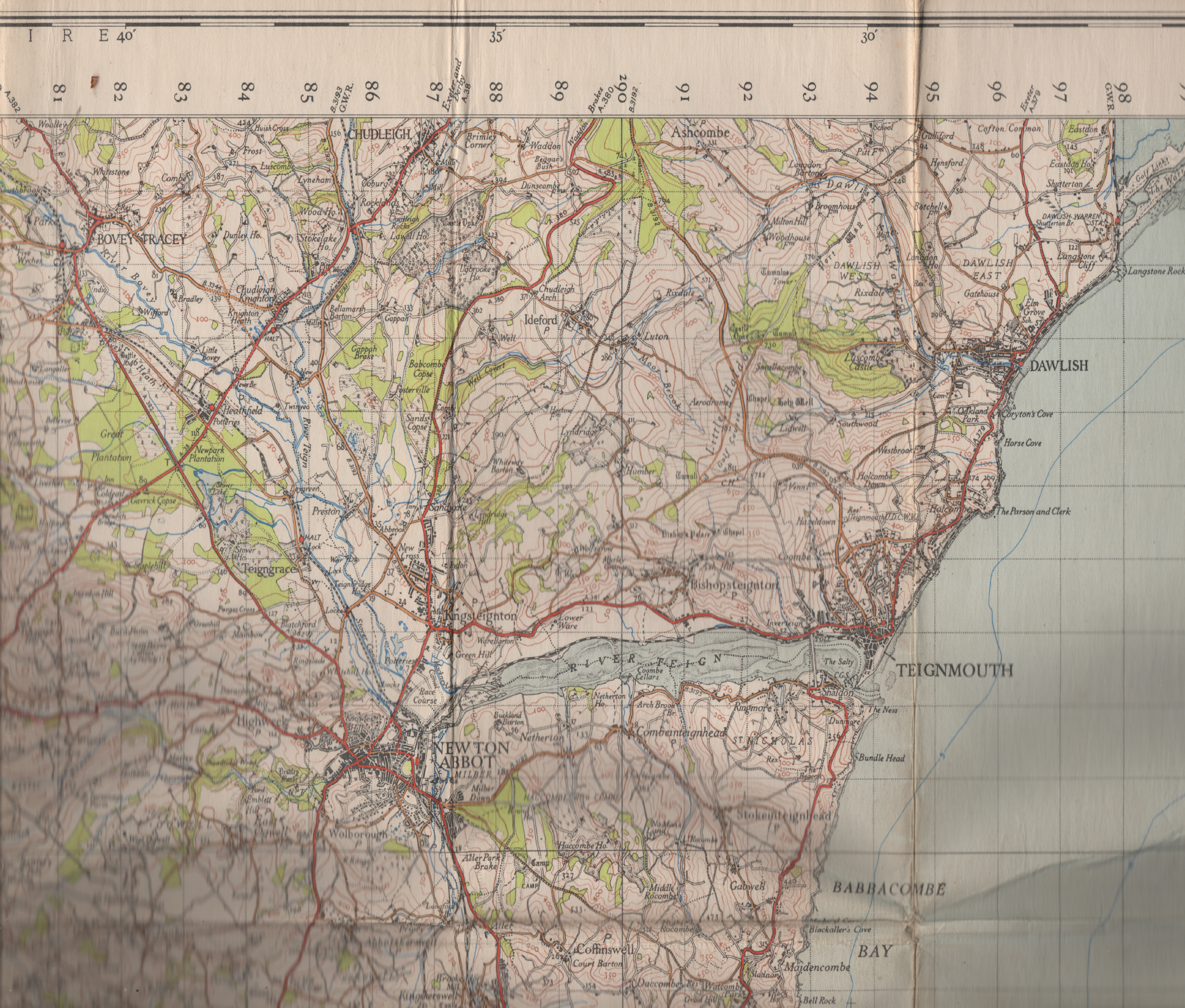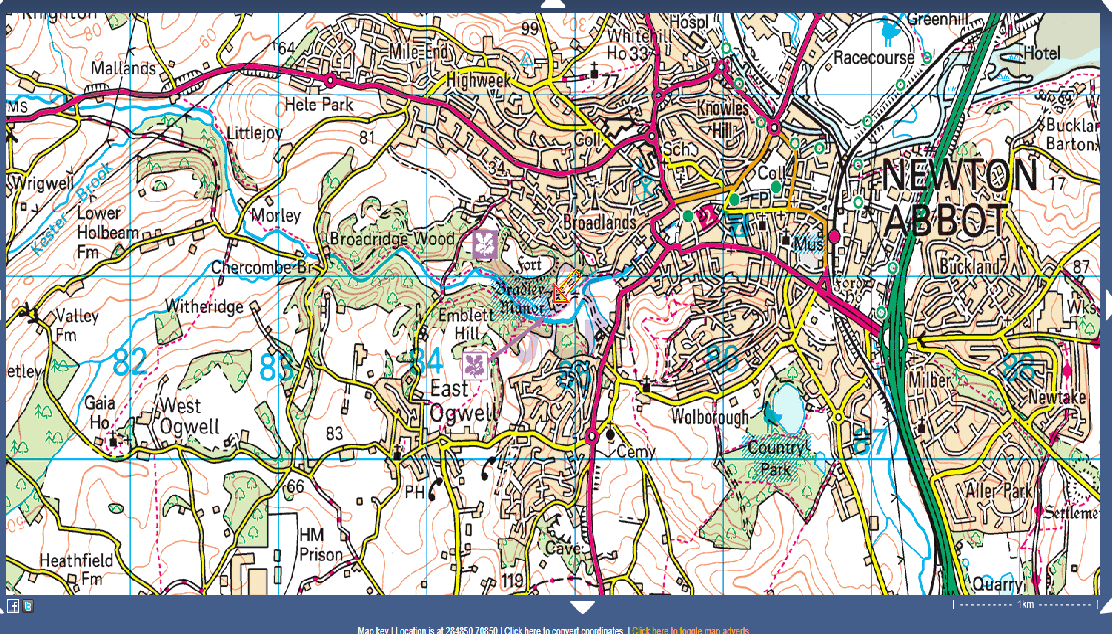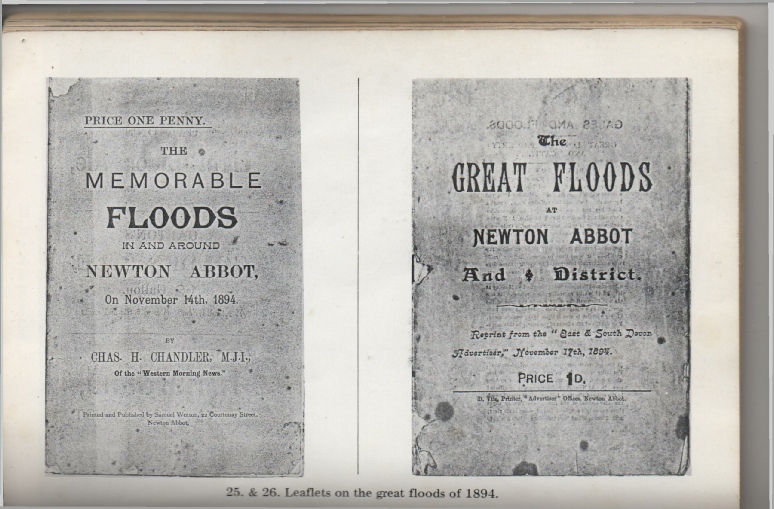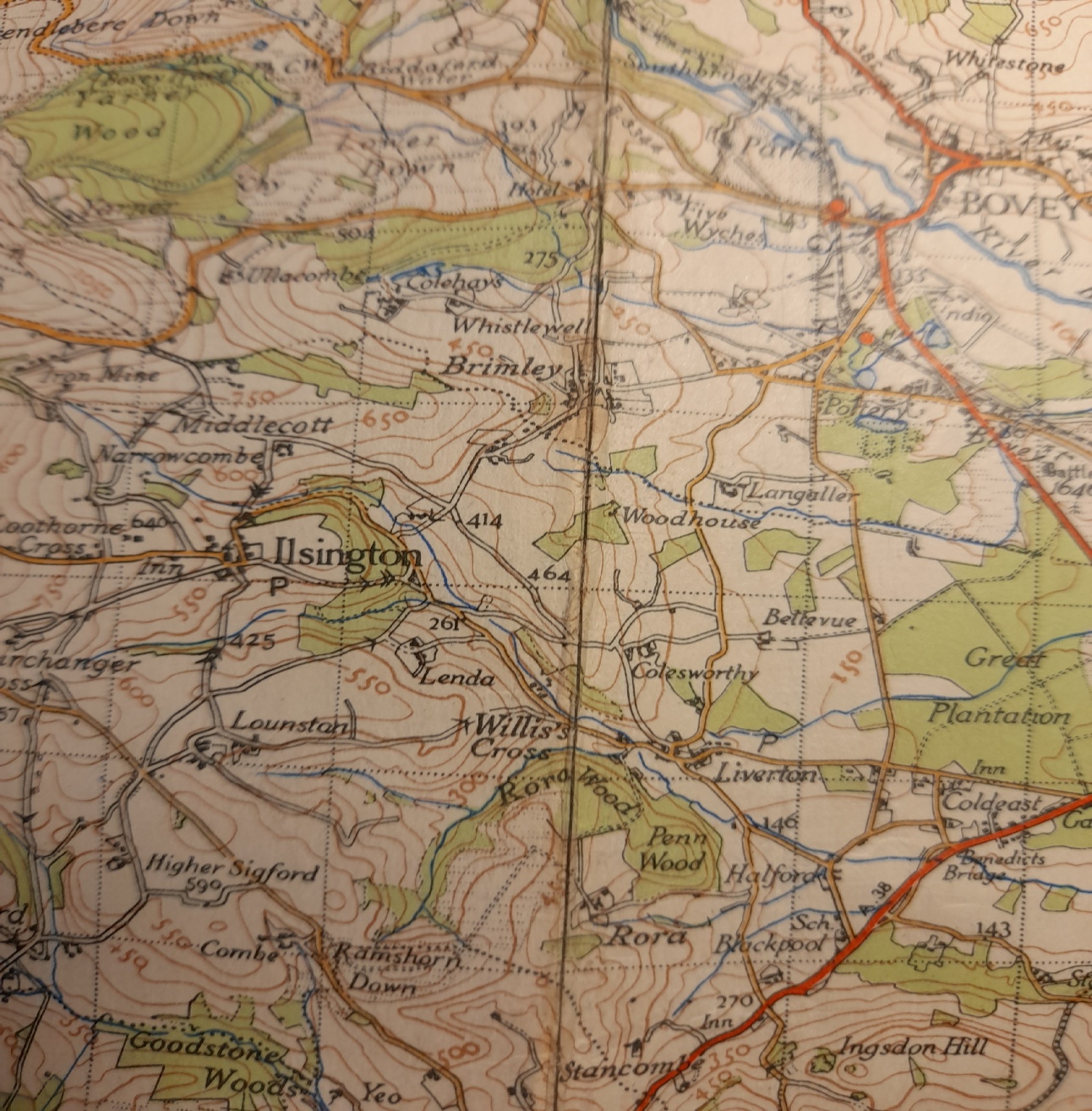

Tor — and here I quote from Crossing’s Guide to Dartmoor where he says ‘Risdon speaks of a noted place called Saddletor from the hills near which the Lomen or as we now call it, the Lemon — “ fetcheth her fountain” . The nearest stream to the tor is the Sig which rises on Bag Tor Down about 1/4 mile S of it . . . it falls into the Lemon (the springs of which are near Lud Gate) just below Sigford, and immediately after having received the waters of the Langworthy Brook.’ All of which we shall be investigating in due course.
This particular stream, which becomes the River Sig, runs past Bugtor cottages and is typical of these moorland streams, deep set in ferns and bright flowers among the rocks as they chatter busily onwards, and it was here that Syd Wills, now living at St Budeaux, spent many happy hours of his childhood, and where he told me, ‘It was an unwritten law to let the foxes drink before you collected the day’s water supply from the brook.’ He went on to tell me of the two Indies who once ran Bagtor House and the Barton as guesthouse and farm, their names Miss Blankiron and Miss Cross.
Memories of them too came from Miss Catherine Haines, now in her 80s and living at Bridford. She was a groom at Bagtor House in the 1920s. And here once again the tragedy of fire touched the Lemon’s tributary, the Sig. Early one morning she got up at five to go cubbing and saw clouds of smoke coming from the neighbouring farm of Westabrook, an old thatched house standing near the banks of the river. She rushed down to wake up the Retallick family, who lived there, and to help the oldest member of the family from his bed and into the barn for safety. Eventually the fire engine arrived, ‘But,’ she said, thore was some problem over getting the pump started to take water from the stream, and I had to chase off to another farm for fuel. Meanwhile Mr Retallick was concerned about his watch which, as
was his habit, he had tied to the bedpost for the night. It was resn ii‘(l — only to be stolen from him later. His son, Mr H. Retallick, now farms Bagtor Barton and he told me that recently when they were doing some repairs at Bagtor cottages they took down a partition and uncovered a small cubby hole like the ones from which lickots are sold at railway stations. ‘My guess is that is where they paid the men who worked in Newtake and Crownley Mines,’ he said and there are also the remains of a blacksmith’s shop and blowing house on the common.’ lie too remembered the two ladies from the Big House. ‘Proper
which have occurred on its banks. Here, at its beginnings, controversy once raged, for water used to be taken from it to feed the leat or pot water, the sole supply for Ilsington village, and Dick Wills, parish historian of Narracombe, whose family have farmed there for fourteen generations, told me there were many accusations from the thirteenth century onwards that too much water was taken, thus depriving the manor mill, Bagtor, of its supply, whilst the leat was feeding the mills of Ilsington, Liverton and Pool. ‘It seem s,’ he said ‘that there was a trough at the source and from
a hole in this the water ran through the fields to Ilsington. The villagers used to go and make the hole bigger so more water ran theirway. This caused a certain amount of ill feeling! ’ But for a moment we come back to the present century. On the night of 6 March 1970, when the Bovey police and their 250 guests were enjoying their twenty-
looking over the gate is the whistling of the wind through the glassless windows. The owners did want to rebuild it on a bigger scale, but the plan was turned down by the Dartmoor National Park
Committee. At the entrance is a board which states CLOSED UNTIL FURTHER NOTICE. Could it perhaps be forever ? Let us look now at something beautiful instead, for it is only fair tovisit the Lemon’s main tributary while we are on this part of the moor — the River Sig which rises in Bagtor Mire under Rippon
Berry's Wood is an Iron Age hill fort situated close to Newton Abbot in Devon, England. The fort is situated at about 75 metres above sea level on a commanding promontory above the River Lemon with views down the Teign Estuary. It lies on the hilltop above Bradley Manor.
The fort was first described in print in 1950 by Aileen Fox, who said that its defences consist of a single limestone rampart and a ditch. Its main entrance at the south-
The River Lemon is a 9.9 mile (16 kilometre) river in the county of Devon in southwest England. It is a tributary of the River Teign, starting on Dartmoor by Haytor, and ending in Newton Abbot.[1] It rises on the south-
A considerable length of the River is designated as a Special Area of Conservation -
The name Lemon is a derivative of a Celtic word meaning elm. authors note as above ,






resting place where while the ear is delighted with the sinless notes which make the dell vocal, the eye is no less pleased by the gambols of the little fishes as they sport in the liquid stream.’ Isn’t that delightful ? Mr Bath told me that the ford at Ogwell was more than likely in use long before ‘The Romans came to Rye or out to Severn strode’, once more the study of the hedgerows dating them as pre Norman, and the ‘relic’ meadows either side where he has found pale flax proving the pasture has been undisturbed for centuries and un
treated with chemicals. He added that a beautifully polished Neolithic axe probably made of greenstone or volcanic rock from the Knowles hill area had been found in the bed of the river during the last century.Woods and trees are always exploited by the people of their time, and Bradley is no exception, last being coppiced in 1918 when the alders were cut down and used to make clogs, being shaped and rough hewn on the spot by the men who felled them. But it has also had its moments of history, for the Rev. William Yeo, for fourteen years the clergyman in charge of the parish and church of Wolborough, was the founder of the body from which the Congregational church eventually sprang. He was ejected from Wolborough in 1662 and used to hold meetings at night in the pit on the Ogwell side of the woods. In 1672 he was licensed as a minister and Rhodes goes on to tell us in his History of Newton that he preached in Newton Bushel and in 1689 his house at Rydon was licensed as a place of general worship. He conducted his services in this pit for those who desired liberty to worship God according to the dictates of their conscience and who were compelled to leave the church they loved and find a place for a service of prayer and praise among the quiet beauty of the rock and woods in God’s own temple. He resigned his living and to avoid persecution so rife in those troublous times met his sympathising parishioners by night in Bradley woods for the worship of God till a chapel was built in Wolborough Street at which he became minister and thus the founder of Non Conformity in Newton Abbot. Mr Norman Roberts, a solicitor in Newton Abbot, also a councillor and non conformist, bought the pit with right of access and presented it to the Congregational church, which is now part of the United Reform Church. This pit in which they held their meetings two hundred years ago is about thirty feet deep with rocky sides and
49
be taken from it to feed the leat or pot water, the sole supply for llsington village, and Dick Wills, parish historian of Narracombe, whose family have farmed there for fourteen generations, told me there were many accusations from the thirteenth century onwards that too much water was taken, thus depriving the manor mill, Bagtor, of its supply, whilst the leat was feeding the mills of Ilsington, Liverton and Pool.* It seems,’ he said ‘that there was a trough at the source and from a hole in this the water ran through the fields to Ilsington. The villagers used to go and make the hole bigger so more water ran their way. This caused a certain amount of ill feeling! ’But for a moment we come back to the present century. On the night of 6 March 1970, when the Bovey police and their 250 guests were enjoying their twenty-
FURTHER NOTICE. Could it perhaps be forever?
Let us look now at something beautiful instead, for it is only fair near which the Lomen or as we now call it, the Lemon — “fetcheth her fountain” . The nearest stream to the tor is the Sig which rises on Bag Tor Down about ¼ mile S of it . . . it falls into the Lemon (the springs of which are near Lud Gate) just below Sigford, and immediately after having received the waters of the Langworthy Brook.' All of which we shall be investigating in due course. This particular stream, which becomes the River Sig, runs past Bagtor cottages and is typical of these moorland streams, deep set in ferns and bright flowers among the rocks as they chatter busily onwards, and it was here that Syd Wills, now living at St Budeaux, spent many happy hours of his childhood, and where he told me, ‘It was an unwritten law to let the foxes drink before you collected the day’s water supply from the brook.’ He went on to tell me of the two ladies who once ran Bagtor House and the Barton as guesthouse and farm, their names Miss Blankiron and Miss Cross. Memories of them too came from Miss Catherine Haines, now in her 80s and living at Bridford. She was a groom at Bagtor House in the 1920s. And here once again the tragedy of fire touched the Lemon’s tributary, the Sig. Early one morning she got up at five to go cubbing and saw clouds of smoke coming from the neighbouring farm of Westabrook, an old thatched house standing near the banks of the river. She rushed down to wake up the Retallick family, who lived there, and to help the oldest member of the family from his bed end into the barn for safety. Eventually the fire engine arrived, ‘But,’ she said, there was some problem over getting the pump started to take water from the stream, and I had to chase off to another farm for fuel. Meanwhile Mr Retallick was concerned about his watch which, as was his habit, he had tied to the bedpost for the night. It was rescued — only to be stolen from him later. His son, Mr H. Retallick, now farms Bagtor Barton and he told me that recently when they were doing some repairs at Bagtor cottages they took down a partition and uncovered a small cubby hole like the ones from which tickets are sold at railway stations. ‘My guess is that is where they paid the men who worked in Newtake and Crownley Mines,’ he said ‘and there are also the remains of a blacksmith’s shop and blowing
front part being built in Queen Anne style, and Dick Wills told me,
‘I have some accounts of it in 1770 in which it is spoken of a a a
“modern house'but we must remember that in Devon they were
about fifty years behind in their styles — in other words the archi
tecture of Queen Anne, current in London during her reign, wa$
copied some fifty years later down here!'
The house has an interesting history for John Ford, the Elizabeth
an dramatist and poet, lived there, having been baptised at Usin